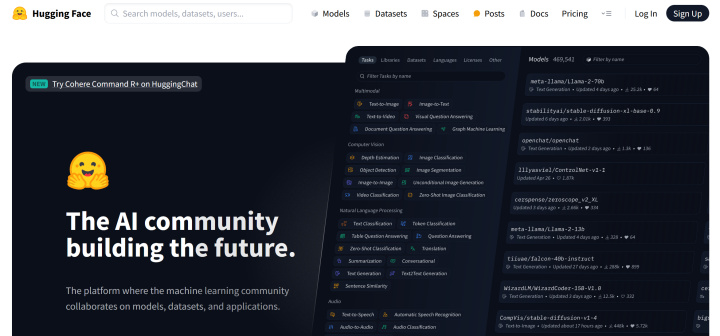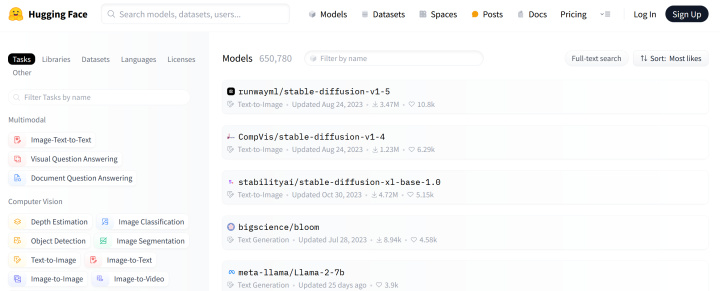What is Hugging Face?
The phrase "Hugging Face" is well known to every developer and active user of AI and ML technologies. Today, this site is the largest hub of tools and data for audiences interested in artificial intelligence and machine learning. In this article, we will tell you what Hugging Face is and what capabilities it has. You will learn about its advantages, limitations, and role in the industry.
How the Hugging Face Project Emerged and Developed
Hugging Face is a platform for creating programs in the field of artificial intelligence, machine learning, and data science. It provides the infrastructure for implementing AI and ML technologies and provides access to language models and datasets. In addition, it provides tools for developing neural networks.
The service is owned by the French-American company of the same name from New York, founded in 2016 by entrepreneurs Clément Delangue, Julien Chaumond, and Thomas Wolf. The company borrowed its name from one of the widely used emojis. Its first product was a chatbot for teenagers. After launching an open-source chatbot in 2017, the founders decided to create a public platform with useful content for AI and ML enthusiasts.
In 2018, Hugging Face made a library of ML models of the “transformer” type publicly available. It includes pre-trained large language models (LLMs), including Bert and GPT from OpenAI. The appearance of such a valuable database on the internet was one of the most significant events in the history of the AI community.
In March 2021, the company raised $40 million in a Series B investment round. In April of the same year, it initiated the BigScience project to develop its own LLM together with other research groups. The result of their collaboration was the BLOOM neural network presented in 2022 with 176 billion parameters.

In December 2021, Hugging Face bought the open-source Gradio library containing data for developing ML applications in Python. In May, it announced a new round of Series C funding, after which its valuation increased to $2 billion. In August 2022, the developers introduced Private Hub, an enterprise version of the public Hugging Face Hub with support for SaaS and on-premise deployment.
A partnership with Amazon Web Services launched in February 2023 made Hugging Face products available to AWS users. Additionally, the company has begun developing a new version of LLM BLOOM on Amazon's Trainium ML chip. In August 2023, the firm received $235 million in Series D funding, increasing its capitalization to $4.5 billion.
So, now you know what Huggingface is, how this service appeared and developed. We invite you to get acquainted with its main tools and capabilities.
Key Tools
Hugging Face offers a number of useful tools for developers and AI/ML enthusiasts. Among them, there are several main ones:
- Model Hub. The service library contains more than 300,000 models with the ability to sort by type and other parameters. This makes it the largest database of AI/ML models on the internet. The most in demand are Hugging Face Transformers, trained and optimized to perform text generation, analysis, translation, and editing tasks.
- Tokenizers. This tool is designed to convert text into a format readable by ML models. It helps to process text information in different languages and with different structures. Tokenizers break text into tokens (words, subwords, and characters). This allows neural networks to understand human language.
- Datasets. The library of NLP datasets used in training, testing, and analyzing language models includes a solid collection of datasets. You can view and work with them in the Hugging Face Hub. Additionally, users can easily add any of the Huggingface datasets to their code.
- Spaces. The platform provides a convenient interface for working with models that does not require special technical knowledge and skills. In the “Spaces” section, there is an impressive list of ready-made solutions of different types: generators of text, images, music, and so on.
Each user of the service gets the opportunity to develop and train their own model based on datasets and other tools. Hugging Face offers all the resources you need to fully test and deploy ML models. Thus, anyone can see how the neural network they created works, modify it, and then publish it in the model library. The platform provides basic computing resources to run demo versions: 50 GB of disk space, 2 CPU cores, and 16 GB of RAM.
Objectives and Areas of Application
Versatile functionality, a large catalog of open-source neural networks, and an active community make it possible to use the platform to solve many problems in different areas. Let's look at a few examples:
- Implementation of ML models into user programs. The platform contains several hundred thousand open-source models for various purposes: for natural language processing (NLP), image generation, audio and video, computer vision, and more. Developers can freely use them in their services and applications.
- Training and distribution of ML models. Hugging Face offers the ability to train and tune deep learning models using API tools. Ready-made neural networks can be shared with other community members by adding them to the Spaces and Transformers libraries.
- Exchange of datasets. The platform helps users exchange data with each other to train language models. They can freely publish them and download them from the dataset library hosted on the site.
- Hosting demo versions. Hugging Face is the largest host of interactive language model demos. It allows you to develop a demo version of the program using your computing resources and then test and run it in a browser.
- Analysis of ML models and datasets. The service gives you access to your own library of code for analyzing and evaluating machine learning models and datasets.
- Development of business applications. The enterprise version of Hugging Face Enterprise Hub provides SaaS services to companies with model deployment in a private environment.
- Scientific research. The project community participates in joint research activities. The most famous among them is the BigScience seminar on the development of NLP technologies. The result of this collaboration was the BLOOM language model, released in 2022.
How to Use Hugging Face

To get started using Hugging Face, we recommend following these steps:
- Registration. Go to huggingface.co and create an account by clicking on the "Sign up" button. Fill in the required information and confirm registration via your email.
- Studying models. Use the "Models" section to view the available models. For convenience, they are divided into categories: text, sound, images. For example, BERT and GPT may be suitable for working with text.
- Testing. After selecting a model, go to its page and use the “Try it out” interactive window to test. Paste text or download a data file to test how your model performs.
- Model integration. To implement the model into your project, use the instructions in the "Use in your project" section. This could be a link to a Python library or an API for working over the internet.
- Communication with the community. If you have questions or need assistance, please visit the Discussions forum. There you can get answers and exchange experiences with other users and developers.
These simple steps will help you better understand how to use Huggingface, get started with it, and use modern advances in AI for your projects.
Advantages and Limitations
Huggingface is the GitHub for the AI/ML community. The popularity of this project is ensured by a number of its advantages. Among the main ones are the following:
- Availability. The platform makes artificial intelligence and machine learning technologies available not only to large corporations but also to individual developers. It provides hundreds of thousands of ready-made open-source ML models, computing resources for training them, fine-grained development scripts, and an API for deploying neural networks.
- Prototyping. The service contains professional tools for the rapid development of prototypes and the deployment of NLP and ML applications.
- Cost optimization and scalability. Hugging Face empowers individuals and enterprises to launch cost-effective AI/ML products with flexible scalability. By using predefined models and other solutions instead of developing an LLM from scratch, businesses significantly optimize their budget.
- Integration. Users can integrate different ML frameworks from the platform database. For example, the Huggingface Transformers library supports integration with the TensorFlow and PyTorch frameworks.
However, the project has some limitations:
- Lack of resources. The computing resources of the platform do not allow the use of all ML models available in its library. Often, they are only enough for a demonstration run but not for the full-scale deployment of neural networks. Accordingly, developers have to rent resources in other places.
- Search system. The search function in the large database of Huggingface does not always work perfectly. This makes it difficult to find specific models, libraries, or tools.
- Content bias. The majority of models available on the platform are created and trained by third-party developers. This creates the risk that they will generate inaccurate, illegal, or inappropriate information.
- Data security. Corporate users should make sure that their data is reliably protected by the security measures offered by the service.
The Implications of Hugging Face for the AI and ML Ecosystem
Knowing what Hugging Face does and what capabilities it has, one cannot help but note the enormous importance of this project for the community and the entire AI and ML ecosystem. The main role is played by the openness of the content it offers. Thanks to this, artificial intelligence and machine learning technologies become available to the widest possible audience.


Hugging Face allows members to choose any ML model from a large library and implement it into their products absolutely free. Equally important are the tools provided by the platform for training, testing, and deploying neural networks. Hugging Face is not only the largest database of language models and tools but also a favorable environment for the spread of innovation. It promotes the development of advanced technologies, making them more powerful, convenient, accessible, and inclusive.
Conclusion
Hugging Face is an AI/ML database and platform for developers in the field of artificial intelligence, machine learning, and data science. It has gained fame and popularity due to its library of open-source models, as well as tools for training and running them. The platform is actively developing and has a lively community, which includes both experienced AI/ML specialists and users interested in this promising area.
Apix-Drive is a simple and efficient system connector that will help you automate routine tasks and optimize business processes. You can save time and money, direct these resources to more important purposes. Test ApiX-Drive and make sure that this tool will relieve your employees and after 5 minutes of settings your business will start working faster.

